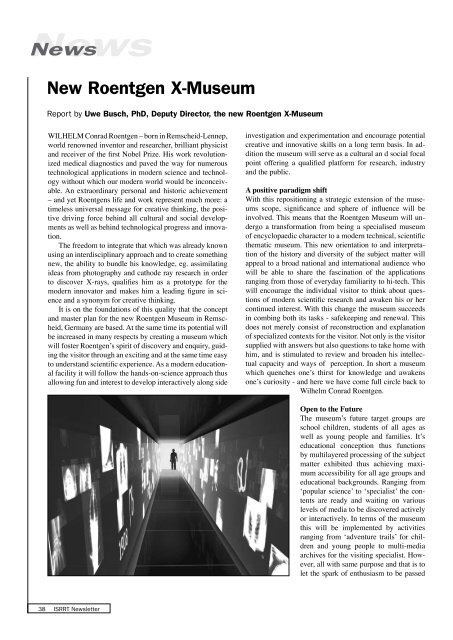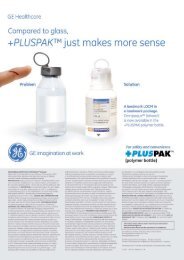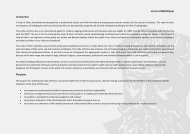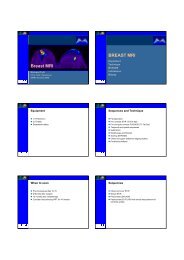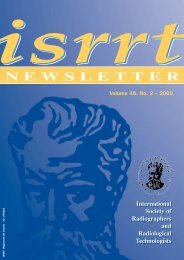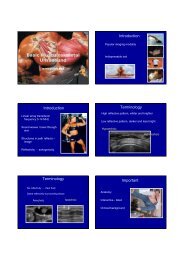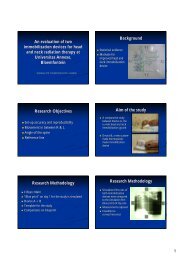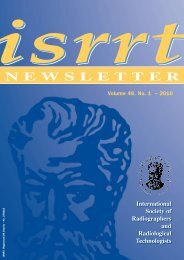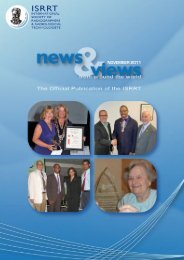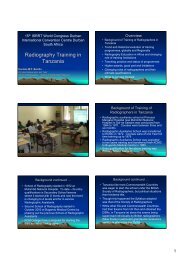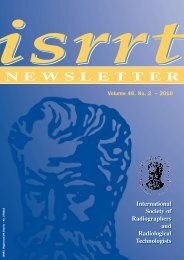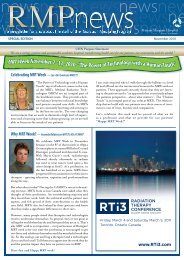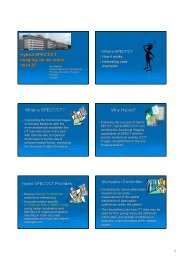NEWSLETTER - ISRRT
NEWSLETTER - ISRRT
NEWSLETTER - ISRRT
Create successful ePaper yourself
Turn your PDF publications into a flip-book with our unique Google optimized e-Paper software.
News<br />
New Roentgen X-Museum<br />
Report by Uwe Busch, PhD, Deputy Director, the new Roentgen X-Museum<br />
WILHELM Conrad Roentgen – born in Remscheid-Lennep,<br />
world renowned inventor and researcher, brilliant physicist<br />
and receiver of the first Nobel Prize. His work revolutionized<br />
medical diagnostics and paved the way for numerous<br />
technological applications in modern science and technology<br />
without which our modern world would be inconceivable.<br />
An extraordinary personal and historic achievement<br />
– and yet Roentgens life and work represent much more: a<br />
timeless universal message for creative thinking, the positive<br />
driving force behind all cultural and social developments<br />
as well as behind technological progress and innovation.<br />
The freedom to integrate that which was already known<br />
using an interdisciplinary approach and to create something<br />
new, the ability to bundle his knowledge, eg. assimilating<br />
ideas from photography and cathode ray research in order<br />
to discover X-rays, qualifies him as a prototype for the<br />
modern innovator and makes him a leading figure in science<br />
and a synonym for creative thinking.<br />
It is on the foundations of this quality that the concept<br />
and master plan for the new Roentgen Museum in Remscheid,<br />
Germany are based. At the same time its potential will<br />
be increased in many respects by creating a museum which<br />
will foster Roentgen’s spirit of discovery and enquiry, guiding<br />
the visitor through an exciting and at the same time easy<br />
to understand scientific experience. As a modern educational<br />
facility it will follow the hands-on-science approach thus<br />
allowing fun and interest to develop interactively along side<br />
38 <strong>ISRRT</strong> Newsletter<br />
investigation and experimentation and encourage potential<br />
creative and innovative skills on a long term basis. In addition<br />
the museum will serve as a cultural an d social focal<br />
point offering a qualified platform for research, industry<br />
and the public.<br />
A positive paradigm shift<br />
With this repositioning a strategic extension of the museums<br />
scope, significance and sphere of influence will be<br />
involved. This means that the Roentgen Museum will undergo<br />
a transformation from being a specialised museum<br />
of encyclopaedic character to a modern technical, scientific<br />
thematic museum. This new orientation to and interpretation<br />
of the history and diversity of the subject matter will<br />
appeal to a broad national and international audience who<br />
will be able to share the fascination of the applications<br />
ranging from those of everyday familiarity to hi-tech. This<br />
will encourage the individual visitor to think about questions<br />
of modern scientific research and awaken his or her<br />
continued interest. With this change the museum succeeds<br />
in combing both its tasks - safekeeping and renewal. This<br />
does not merely consist of reconstruction and explanation<br />
of specialized contexts for the visitor. Not only is the visitor<br />
supplied with answers but also questions to take home with<br />
him, and is stimulated to review and broaden his intellectual<br />
capacity and ways of perception. In short a museum<br />
which quenches one’s thirst for knowledge and awakens<br />
one’s curiosity - and here we have come full circle back to<br />
Wilhelm Conrad Roentgen.<br />
Open to the Future<br />
The museum’s future target groups are<br />
school children, students of all ages as<br />
well as young people and families. It’s<br />
educational conception thus functions<br />
by multilayered processing of the subject<br />
matter exhibited thus achieving maximum<br />
accessibility for all age groups and<br />
educational backgrounds. Ranging from<br />
‘popular science’ to ‘specialist’ the contents<br />
are ready and waiting on various<br />
levels of media to be discovered actively<br />
or interactively. In terms of the museum<br />
this will be implemented by activities<br />
ranging from ‘adventure trails’ for children<br />
and young people to multi-media<br />
archives for the visiting specialist. However,<br />
all with same purpose and that is to<br />
let the spark of enthusiasm to be passed


